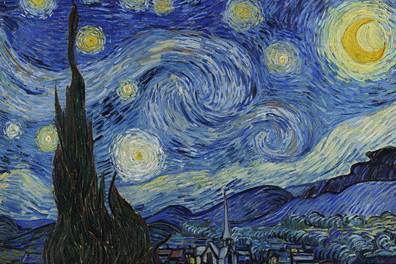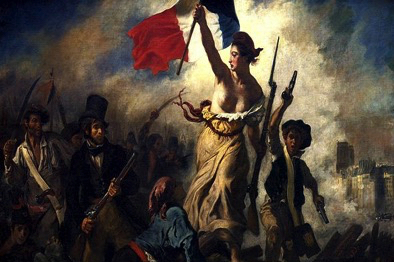The Dualism of Feelings
|
When I was a junior at Muskingum College, I took a required 10-hour art history class, which changed my life. During that year, a learned a great deal about art and the history surrounding painters, sculptors, writers, musicians, and architects. In addition, the professor, Louie Palmer, asked me to be his teaching assistant in my senior year. During that year, I learned that I could teach and loved that experience. I taught a handful of subsections each week, wrote, and graded both the midterms and finals each semester. That opportunity helped me become aware of what I was capable. It was transformative. Every student graduated from Muskingum with a very comprehensive understanding of art history. Starting with the prehistoric caves in Lascaux and Altamira, we would cover the complete development of the visual arts up to the post-modernist painters. Of all the various humanity classes that I have taught, teaching art history is the class that I love and enjoy the most. Additionally, it is a type of historic umbrella over the development of human civilization. What happens in society affects the various arts. However, what happens in the various arts also affects society. One cannot have a true understanding of civilization without knowing what was happening in the area of the arts. It is also critically important to understand what drives the artists to be creative. Artistic expression is due primarily to pain that the artist is facing. Pick any artist, and you will find something that drove the artist to his or her creative expression. Art functions as a means of expression for whatever that person's political, emotional, psychological, or physical problems happen to be. When I teach art history, each student picks an artist upon which to do his or her term paper. It does not take long before they see how pain affects that artist. This realization is critical at two levels. The students see that occurrence in the art world. At the first level, it is educationally informative to learn about the artist and how the artist deals with his or her pain. The second level is educationally informative for each of the students to see how their personal pains in life can motivate them in their lives. Whether the student is artistically creative or not, pain can be a major motivating force in all of their lives. On December 19, 2014, Mr. Turner, the movie, was released. It is a story of Joseph Mallord William Turner who interestingly died on December 19, 1851. Surely, I am not the only person that noticed the release and death date similarity. Additionally, to be honest with you, I considered waiting until April 23, which was Turner's birthday in 1775 to release this article. However, understanding what Mr. Turner can teach us is more important than playing the dating-game in late April. Besides, the movie had only a limited release to selected cities for a couple of weeks. However, you can go to places on the Internet like iTunes, Amazon Video, Vudu, and YouTube and rent Mr. Turner. 
Just over a century after his death, I was taking The Arts at Muskingum. It was there that Professor Louie Palmer introduced William Turner to the class. In fact, The Fighting Téméraire is my favorite painting. In other articles, I have mentioned that I have a framed copy of that painting in my home, on my mouse pad, and on a T-shirt. Jack and Owen, who are five and three, recognize The Fighting Téméraire. Jack will proudly announce to any onlooker, "That's Papa's favorite painting." While the vast majority of Americans has never come across the painting in books or the Internet, nevertheless, it is my favorite for several reasons. 
I like the contrast of colors especially the blues and yellows and the contrast between the past and the present in this painting. The steam driven tugboat is pulling the HMS Téméraire to dry-dock where it will be cut up for scrap. Additionally, I love Turner's artistic lie. Pablo Picasso said to Marius De Zayas in the early 1920s,
Turner told in his painting a lie to communicate a truth. The British Navy destroyed the greatest ship in their naval history for scrap. As Turner reflected upon this travesty, the HMS Téméraire was towed up the River Thames to the docks at Rotherhithe. In reality, Turner lied twice. The Téméraire's funeral procession had the sun setting behind the ship. The sun would have been setting in front of the ship as the tug pulled it to the docks at Rotherhithe. Therefore, Turner reversed the place of the setting sun to show that death and sunset of an old era. 
Mr. Turner and the Fighting Téméraire In addition, the navy had already cut down the Téméraire's masts. The truth was that that tugboat with belching smoke merely towed a wooden hulk of what once was to dry-dock. Turner's two lies were to communicate to the British people the tragedy of what the Royal Navy was doing to this greatest of all British naval vessels. Hence, the pain that Turner saw in the destruction of the Téméraire moved him to paint this famous painting. I went to see the movie, Mr. Turner, on January 1, 2015. While not an art critic per se, I could hardly wait until I saw the movie. However, the movie dealt with a long list of psychological and emotional issues of Joseph Mallord William Turner. It took me only 15-minutes into the film before I was sharing Turner's depression, anxiety, and torment. The movie captured the mind and mindset of the painter. I knew some things about Turner's psychological issues especially related to his mother and poverty as a child. However, the degree of pain and psychological hurt escaped me until the movie. The movie addressed the negativity faced by Turner in Technicolor as it were. Nevertheless, the negativity was the driving force behind the explosion of Turner's creativity. His great pain created great art. Look at the vast majority of Turner's paintings; they generally contrast a large spectrum of blues with a spectrum of reds, oranges, and yellows. His paintings were his autobiographical picture of his mental state. Turner's life was a series of opposites: the good times and bad times, calm times and turbulent times, and bright times and dark times. There is a scene in the film where he is tied to the mast of a ship in the midst of a storm so that he could see what a storm was truly like...upfront and personally. He then goes to his studio knowing in detail what a storm looks like. Interestingly, that is the metaphor of his life. Through the pain, he is able to express it through his paintings. Okay, so what? What difference does it make to know about his pain beyond the truism that pain motivates creativity? Once you understand that reality, what difference does it make to you other than you are more informed about Joseph Mallord William Turner? It does make a huge difference to you whether or not you are at all artistic. Turner is a model of each of us albeit a model on steroids. He dealt with pain and gained from that experience. You need to see Mr. Turner. He created sheer beauty amidst great pain. Therein lies an important lesson for each of us. We need to face our personal pains, and we will gain. This is the trailer for Mr. Turner. This link is to a montage of nearly 1,000 of William Turner's paintings. This is a video of history Jeremy Irons. This is NPR's interview of Timothy Spall who played William Turner.
Visit the On Seeing the Light page to read more about this topic.
Visit the Connecting the Dots page to read more about this topic.
Visit the My Hauntings page to read more about this topic.
Visit the Darkest Before Dawn page to read more about this topic.
Visit The Mentors and Me page to read more about this topic.
Visit the Best and Worst of Times page to read more about this topic. 05/06/16 |












